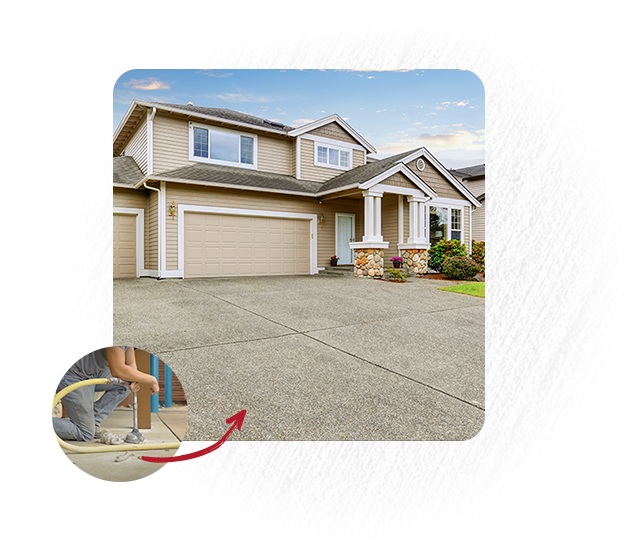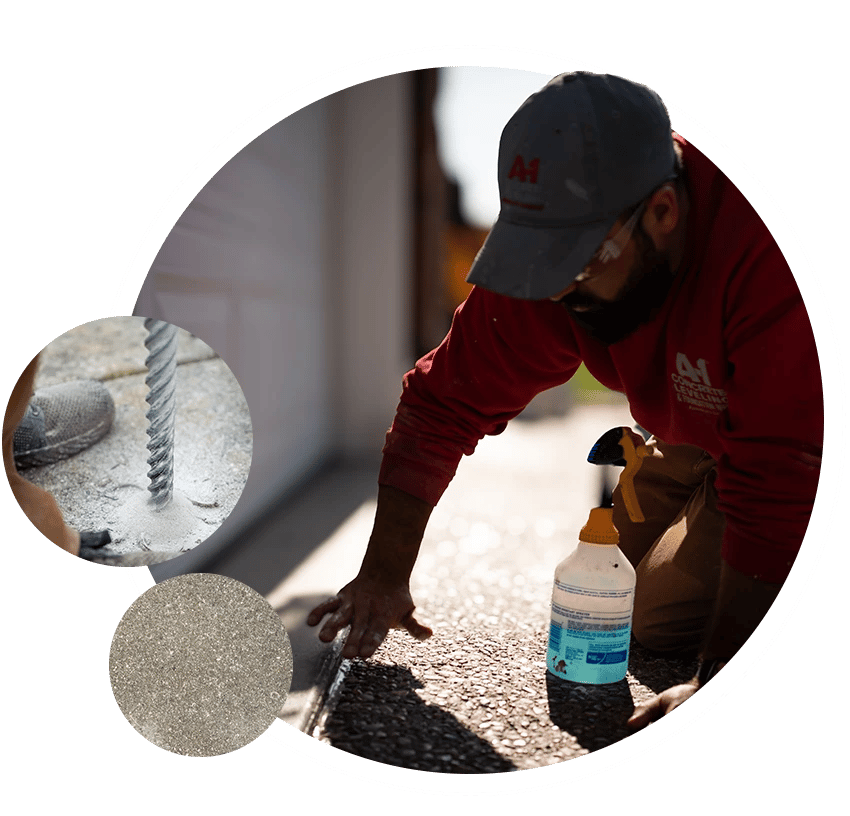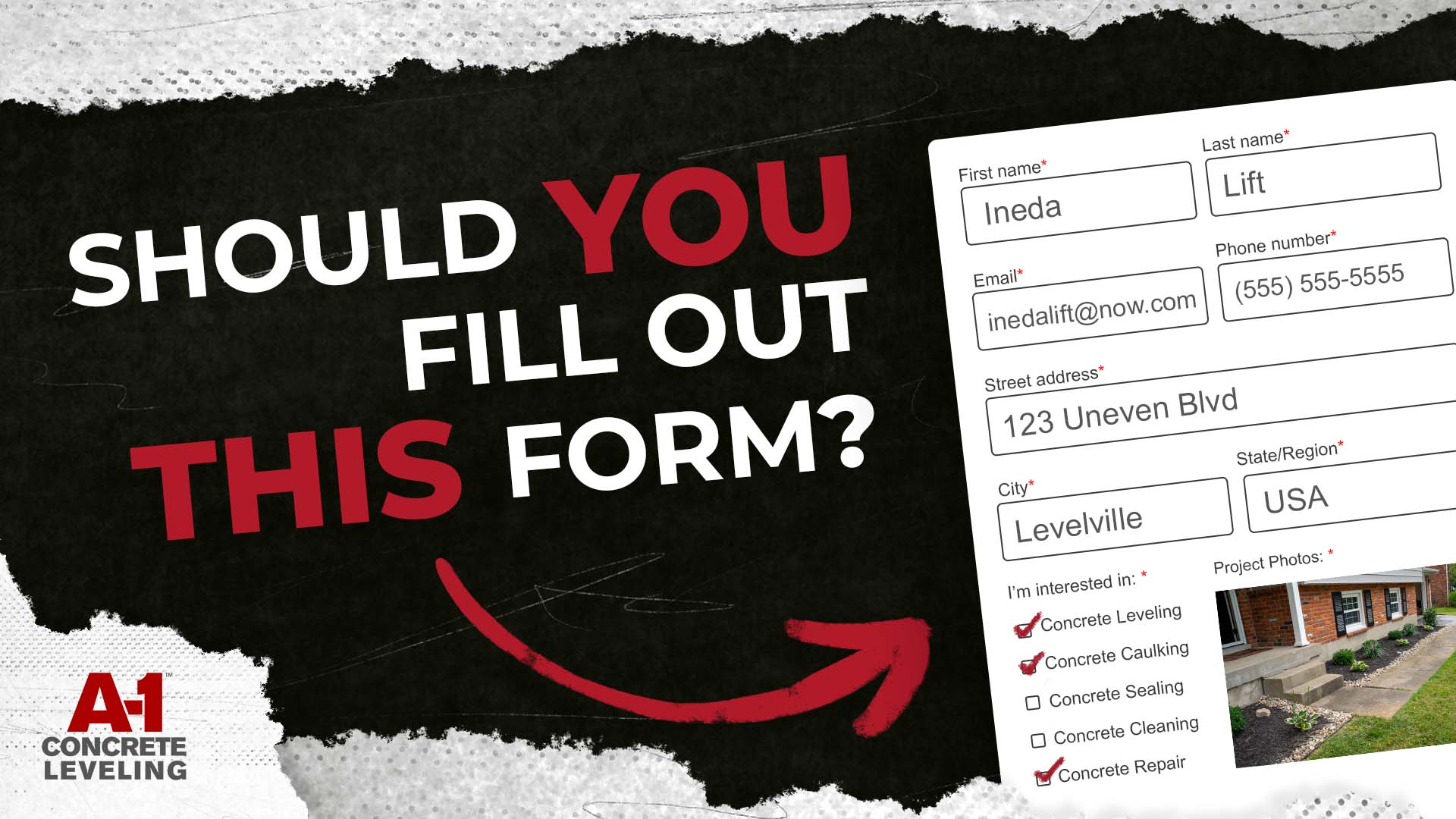Providing your email address will keep you updated should we need to provide updates specific to your location.
Concrete Leveling and Foundation Repair in Richmond, Virginia
Restore your settled, worn-out concrete with A-1 Richmond's money-saving concrete repair and maintenance services.

A-1 Concrete Leveling Richmond
You shouldn’t have to put up with settled, bad-looking concrete. Here at A-1 Richmond, we’ve made it our mission to help you love your concrete again.
Request an EstimateSafe Surfaces
Eliminate trip hazards that risk hurting friends and family, or even legal liability.
Great-Looking Concrete
Get rid of ugly, uneven concrete – it can be embarrassing and lower the value of your property.
Long-Term Savings
Maintain and repair to save money, as bad concrete will worsen over time and lead to bigger bills.
Concrete Repair and Maintenance in Richmond, Virginia
Cracking and settling due to the constant freeze-thaw cycles over the cold Richmond winters makes repairing and protecting your concrete a must.
What our customers are saying
A-1 is #1 in my book!
A-1 Concrete did a fabulous job leveling and repairing the crack in my driveway and leveling a slab of sidewalk in front of my house! They were professional, reasonably priced, responsive, quick, and easy to work with. I highly recommend this company and would definitely use them again.
Lisa Slate
Midlothian
Steps Leveling and Repair
Great people to work with. They came out and did a wonderful job and at a good price. I would use them again and tell my friends.
William O Davis
Richmond
Beautiful, Sound and Artistic Porch Repair
...A wonderful job which repaired the porch and added a beautiful architectural detail to the house!! The next was a sidewalk leveling and repair at my local church where I serve as a deacon. They leveled 10 sidewalk slabs in our 27 year old concrete sidewalk. They did a great job on the badly cracked and uneven sidewalk and their pricing was very reasonable. They were on time and did great work. A very good value!
Joe Herbst
Midlothian, VA
Excellent Service
Not only do we refer A-1 to all of our clients, we have personally used them for our own home. They are always a pleasure to work with, knowledgeable and super friendly!
Jennifer McMurdy
Midlothian, VA
The concrete slab inside of the brick of my back stoop had tilted. A-1 did a fantastic job of correcting the problem. The team is prompt and courteous. Thank you for making the fix so easy and the cost so competitive!!!!
Anne Townsend
Richmand
Excellent Service! Exceeded all of my expectations. Highly recommend!!
Georgina Gozalez
Richmond
Great service!!
Rocky Gonzalez
Richmond
Another Great Job!
I have used A-1 3 times over the past 18 years at three different locations, they have always done an excellent job! They have experience and know what they are doing, don't trust your project to anyone else. Their cost to level or raise sidewalks, porch slabs, patios, etc is much less than the cost to replace existing concrete.
Jeff Tarkington
Midlothian,VA
A-1 Concrete Leveling Richmond
14241 Midlothian Tnpk Suite 220
Midlothian, VA 23113

A-1 Richmond Service Area
Meet the A-1 Richmond Team
Get to know your local concrete repair and maintenance experts!
Stafford Cary
Owner
Stafford Cary
Owner
“I've pretty much been doing concrete my whole life. I've poured concrete. . . You know, we got into this because I'd already worked for the previous owner. I bought this franchise from the guy that started it. We've been in business since 2003.”
4 Simple Steps to Love Your Concrete Again
Step 1. Fill out an online estimate request form and submit photos of the area that needs some love.
Step 2. We’ll call or text you to get more information and put you on the schedule for an estimate.
Step 3. An A-1 Richmond expert will perform a free onsite inspection of your concrete and give you a detailed cost estimate.
Step 4. Once the estimate is approved, we’ll get you on the schedule and perform your repairs or maintenance.

Have More Questions About A-1 Concrete Leveling Richmond?
We’ve got you covered with the answers to some of our most frequently asked questions.
Do you offer a warranty?
Yes, we offer a warranty here at A-1 Richmond. Get in touch to learn more about our warranty terms.
Do you pour new concrete?
At A-1 Concrete Leveling Richmond, we do not pour new concrete.
Our primary service is the care and maintenance of existing concrete that has deteriorated in some way, often saving you a significant amount over the cost of new concrete.
Learn more: When to Repair vs. Replace Your Concrete
Concrete Academy
Your one-stop shop for unbiased insights into all things concrete – from experts who have seen it and done it before.
Schedule your Concrete Repair Estimate
You're just a few steps away from beautiful, renewed concrete.
You'll hear from us within 1 business day to get more information about your project and/or set up an estimate appointment.
During your initial 15-minute call we'll gather information on your current concrete problems, and what you're looking to solve.
